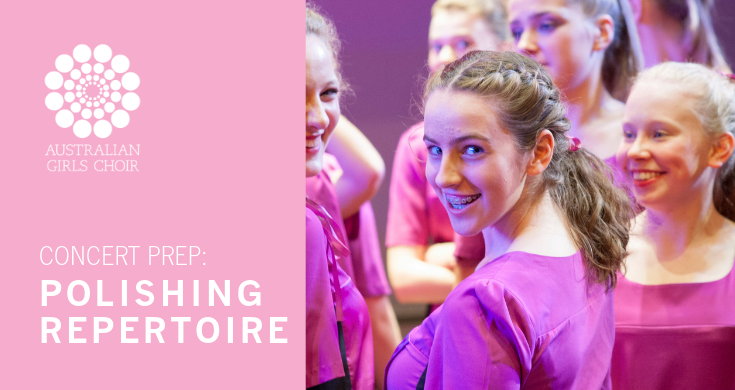
As hundreds of our choristers across Australia prepare for the Australian Girls Choir Annual Concert, we’re sharing our favourite tips and tricks for getting ‘concert ready’.
Today we’re focusing on tips for polishing your repertoire at home!
During concert season you’re going to hear your tutor ask you to practice at home. Many of our choristers ask us, ‘what does this actually mean?’ And that’s an excellent question, because it isn’t always obvious what to actually do.
Today we’re breaking down this question. Laura Knowling, one of our senior singing tutors at the Australian Girls Choir, shares three specific elements she asks her students to work on when they polish their repertoire at home.
1. Don’t run through the whole song.
A lot people think practising means running the whole song again and again. Actually, what you want to do is pick a section of the song and focus all of your attention on refining the details. Work on the lyrics, the phrasing and the choreography. Think about the emotional dynamics and the ‘story’ behind that section of the song. When you really focus on each individual element within that section, you’ll be able to work them into your muscle memory as a whole. This is what it means to ‘polish’ a performance. Then the next time you practice you might choose a different section of the song and work towards combining them all together.
2. Record yourself singing and listen back.
It can be hard to hear yourself accurately when you sing, so try recording yourself and listen back. When you listen to the recording, please don’t judge the performance for whether you think it sounds ‘good’ or ‘bad’. Listen to yourself as if you were your own singing coach. This means listening out for things like how you’re pronouncing each word. Are you breathing in the correct place? Are each of the words clear and easy to understand?
Recording is a really important step because it’s difficult to be critical and creative at the same time. Recording yourself allows you to really sing in the moment and enjoy yourself while you record, and then step into the role of singing teacher to listen out for what might need some work.
3. Sing in front of a mirror.
What you think you look like, and what is actually happening on your face doesn’t always match up. That’s because how something feels emotionally when we’re singing, and how it looks on the outside, doesn’t always translate. Singing in front of a mirror essential to become more self-aware of your stage presence. As soon as you are aware of what you look like when you sing, you can understand and pair that with what it physically feels like. The best example of this is when we ask students to smile more, and they say that they are. When we put them in front of a mirror they’re able to see what smiling looks and feels like when they sing. Then when we take the mirror away, they know what their smile needs to physically feel like for it to look correct.
Good luck with your performance!
If you’re interested in joining the choir and auditioning for our incredible performance opportunities, check out all the details on our Enrolments Page.



